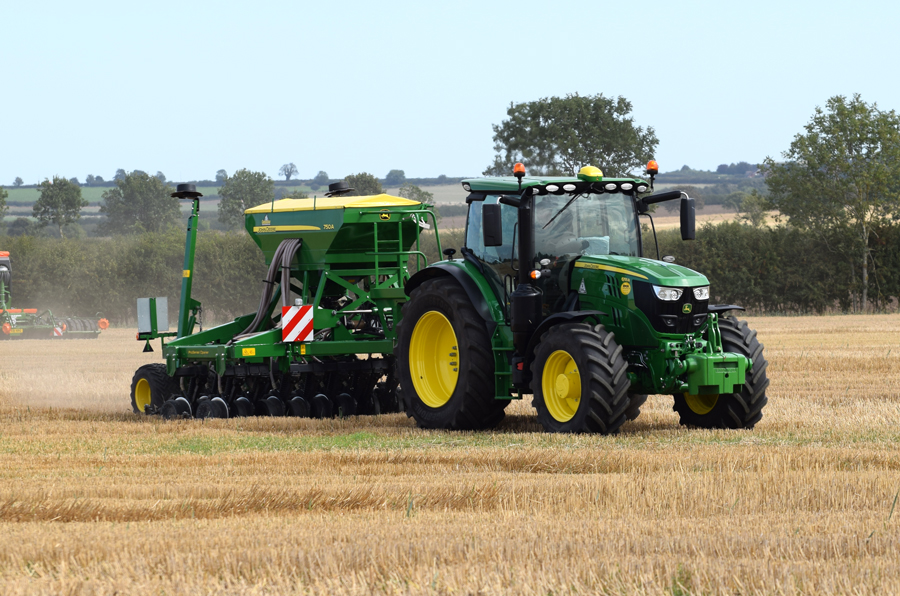Cover crops trial puts direct drills to the test
2nd October 2019
Ten leading drill manufacturers are taking part in a Farmacy trial in Lincolnshire to see how different machines perform when growing cover crops in the rotation.

Ten leading drill manufacturers are taking part in a Farmacy trial in Lincolnshire to see how different machines perform when growing cover crops in the rotation.
The field-scale trial is part of ongoing work at the Waddingworth demonstration site, at A & A W Pritchard’s Redhouse Farm near Woodhall Spa, which for the past three years has hosted various trials investigating the effectiveness of cover cropping options.
Each machine has been allocated a 36m-wide plot to sow an identical mix of oats, crimson clover and white mustard into wheat stubble. Drilling took place at a special open day for farmers on 5 September and plots will be monitored over the autumn to identify any differences in cover crop establishment and growth. Each machine will then return for a second open day in the spring to direct-drill beans into their cover crops.
Farmacy agronomist Alice Cannon says the trial will help show the relative merits of different machine designs and features when sowing cover crops and drilling into them, but insists it is not aiming to conclude whether one option is better than the other.
“Choosing the right drill for your individual circumstances is essential. But any machine will only perform well if it is put into a situation that allows it to do so.
“That means if there are underlying issues with soil structure or soil health, they cannot be changed overnight just by changing the drill.”
Before making any capital investment or changing crop rotation, including growing cover crops, Miss Cannon says growers must first understand how soils behave and rectify any major issues, such as compaction, pH imbalance or poor drainage.
“It starts with using a spade to dig holes to see what’s happening beneath the surface.
“Cover crops can do much for soil health, but they have to be tailored to the situation. Their root power also declines after 3-4 inches, so if there is deep compaction you need to address this separately.”
Accurate soil sampling
Hutchinsons colleague Dick Neale urges caution when examining soils in early autumn, as dry land can be mistaken for being compacted when hardness is actually due to lack of moisture.
“Read all the signs to understand why a soil is like it is.”
Root growth provides a useful indicator of compacted layers, but worm activity, water infiltration, friability and the general texture and “feel” of soil are also important, he says.
Detailed analysis of soil characteristics using the new Terramap high definition mapping service provides an ideal accompaniment to field sampling, Miss Cannon says.
“Terramap provides the detail and science behind what the spade shows you, so the two become a double act.”
Sampling over 800 points per hectare, the gamma ray sensor can measure and map 13 common nutrient properties, soil texture and other variables such as organic matter, plant available water and cation exchange capacity. Readings are unaffected by moisture or ground cover.
“You can use this information to help determine the best cover crop species and how it should be established,” Miss Cannon says.
Managing soil moisture is a big factor in cover crop choice, especially on heavy land ahead of spring drilling, she adds. “Think of cover crops as a pump, drawing water out of the soil. Good rooting also opens up the structure, improves water infiltration, adds organic matter and aids crop growth.”
Cover crops such as berseem clover, vetch and radish offer deeper rooting and water extraction than the shallower, more fibrous rooting of cereal species, she notes. “Each crop has its own characteristics, so be clear what you want to achieve and sow three or four species to take advantage of the different functions they provide.”
For growers looking to try cover crops for the first time, Mr Neale says leaving volunteer oilseed rape as a catch crop ahead of late-sown winter wheat is a good starting point.
“If you’re drilling late on heavy soils, managing soil moisture in upper layers is essential. The best way to do that is with a growing crop to dry soil out, and leave surface crop residues to reduce the impact of heavy rain.”
A comparison of two low-disturbance drills used for sowing wheat into green oilseed rape stubbles on heavy land at Waddingworth shows clear benefits for moisture management, soil friability and seed placement, Mr Neale says.
The even spread of volunteers and good system of fine roots helps condition soil, allowing seed from both the disc and the tine drill, to go into good, friable soil.
Drills on test at Waddingworth :
- Vaderstad Rapid A 600S
- Amazone Cayena 6001
- Weaving GD 480 1T
- John Deere 750A
- Sly Boss
- Mzuri
- Dale Drills Eco XL
- Horsch Avatar
- Sumo DTS
- Claydon Hybrid T4
